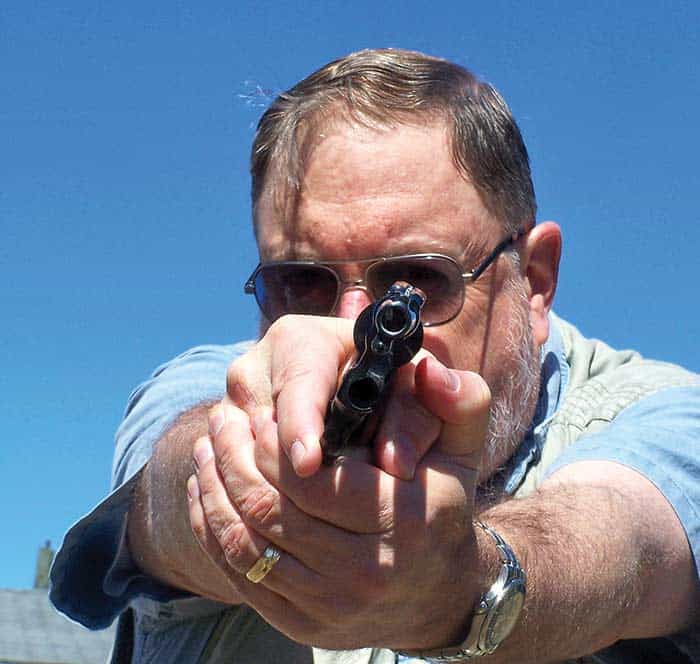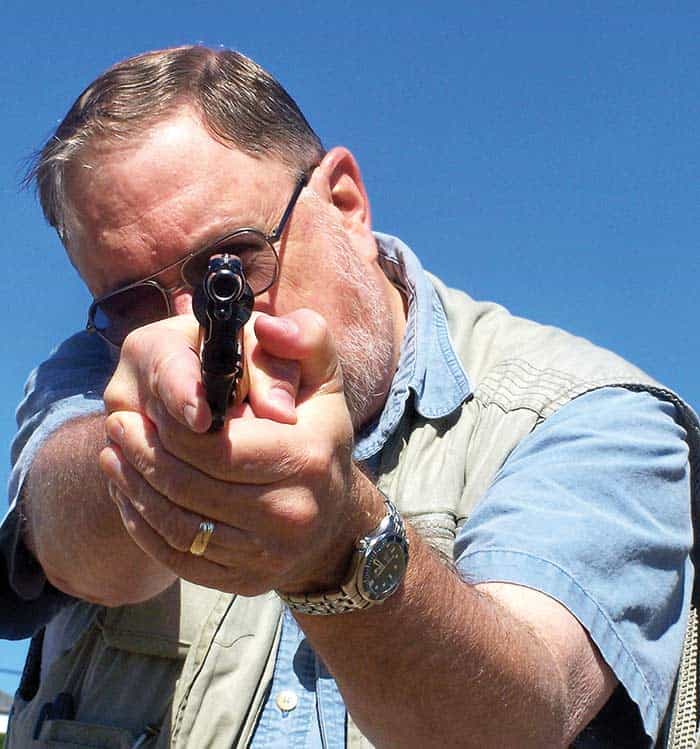THE CROSS-DOMINANT EYES
Corrections are easy
Sally Bartoo is an enthusiastic bull’s-eye shooter and firearms instructor, who happens to be cross-dominant. That is, she is right handed but her master eye is her left one. She learned to shoot left-handed and has won many awards at Camp Perry on down. After she trained with me, she shoots dominant hand for CCW and IDPA.
She still has a strong interest in the topic, though, and recently forwarded some interesting material. A study of 5,546 subjects from 40 years ago determined almost a third were “cross-dom.” 28.6 percent had left eye and right hand preference, while 3.9 percent had right eye and left hand preference. The citation was “Rengstorff, 1967.” The same study found 91.5 percent of those surveyed were right-handed, 7.7 percent southpaws, and 1.1 percent ambidextrous.
Having been teaching the handgun for some 35 years, I’d have to say those figures from four decades ago sound about right. No mention was made in the posting of gender or racial breakdown, but I’ve noticed more African- Americans than Caucasians are crossdominant, far more females than males are cross-dominant and half or somewhat more than half of black females I’ve encountered are too.
Switching to the non-dominant hand is an old tradition. You see it more among lefties, because they’re used to living in a right-handed world and because so many of the guns and holsters are readily available in “righty format only.” The fact is, though, technique can be easily altered to correct this problem.
One-Hand Shooting
The turning of the head on the axis of the neck to bring left eye in line with extended right hand, or vice versa, is awkward. The first to recognize this and correct it was Bill McMillan, shooting for the US Marine Corps team in the late 1950s. McMillan figured out if he simply canted the pistol somewhere from 15 to 45 degrees inboard, adjusting the sights to compensate where necessary, the iron sights of the pistol in his right hand aligned perfectly with his left eye. In 1960 he went Gold for his country and his team in international competition, and the technique was proven.
One of his contemporaries, on the practical pistol side, was Ray Chapman, who would become the first world champion of the combat handgun. Ray wasn’t cross-dominant, but he found a 15 to 45 degree cant of the pistol put the skeleto-muscular support structure of the human arm into a more propitious alignment and strengthened the hand. He recommended it even for same eye/hand dominant shooters, and it is taught today as technique of choice for one-handed self-defense shooting at the Chapman Academy Ray founded and at Thunder Ranch.
It is less popular today with crossdominant bull’s-eye shooters, because the game has gone to red dot sights for the most part, which are higher over the bore axis than iron sights and require significantly more adjustment to compensate for the changed angle between line of sight and line of bore.
Two-Hand Shooting
The Nichols Technique is simply applying the 15 to 45 degree inboard tilt of the handgun toward the opposite eye, while holding the firearm in both hands. It was popularized by Larry Nichols, the famously practical and innovative rangemaster of the Burbank, California, PD.
In cross-dominant use of the classic Weaver Stance, drop your head sideways toward your gun arm’s shoulder. Jack Weaver’s stance, with the body bladed somewhat and both elbows bent, brings the gun strongly toward the dominant eye side, and you need this much head movement to correct. It will bring your left eye in line with gun in right hand or vice versa, but the dropping of the head buries the danger scan more than I like. The non-dominant eye has a great view of your own gun arm but a poor view of the danger scene.
The Chapman Stance, the most popular and probably the most efficient of the many “modified Weaver stances,” is much easier to correct for cross-dominance. In Ray’s stance, the gun arm is locked straight out, and the bent forward arm pulls in tight. This squares the chest a little more, and the gun isn’t so much over on the strong side. Indexing the chin to the bicep of the shooting arm perfectly aligns the opposite eye with the gun arm in the Chapman stance, and keeps the head erect. You don’t lose any danger scan, you just move the field of vision a few degrees to one side.
The Isosceles Stance squares the front of the torso to the target or threat, and both arms are locked straight out, forming an Isosceles triangle vis-à-vis the trunk of the body. This is the most adaptable stance for the cross-dominant shooter, in my experience. The gun and its sights end up at body center anyway, and it’s no harder for the left eye to find the sights than the right eye.
Easier For Handgunners
Correction for cross-dominance is much more difficult for the rifle or shotgun, and there, I actually do recommend the right-handed gunner shoot from the left shoulder if left eye dominant. However, such “mirror image shooting” is also much easier with long guns than with handguns, which are much more dependent on hand dexterity and therefore almost cry out for the dominant hand to take the master grip upon them.
Give the above techniques a try. Even if you’re not cross-dominant, someone you know is … and you will be, if you ever have to shoot weak handed. Finally, don’t worry, you’re in good company. Such great modern champions as Dave Sevigny and Tom Yost are cross-dominant, and it hasn’t kept them out of the winner’s circle.
BY THE NUMBERS
28.6 percent: The number of people determined to be right-handed but left-eye dominant.
3.9 percent: The number of people determined to be left-handed but right-eye dominant.
91.5 percent: The number of people determined to be right-handed.
7.7 percent: The number of people determined to be left-handed.
1.1 percent: The number of people determined to be ambidextrous, who probably don’t need to read Ayoob’s column this month.

Sign up for the Personal Defense newsletter here:










